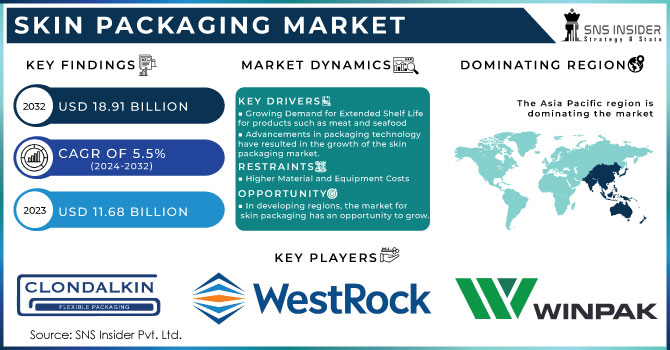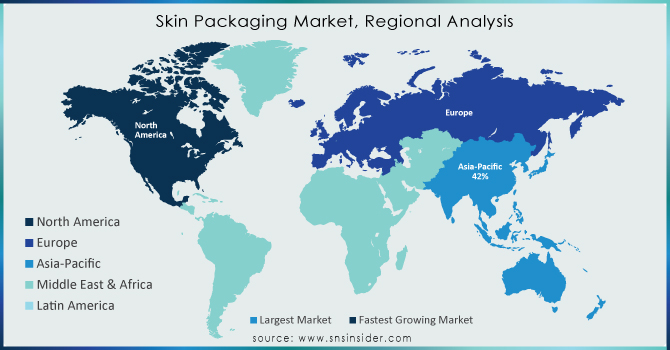Skin Packaging Market Key Insights:

Get Sample Copy of Skin Packaging Market - Request Sample Report
The Skin Packaging Market size was valued at USD 11.68 billion in 2023 and is expected to Reach USD 18.91 billion by 2032 and grow at a CAGR of 5.5 % over the forecast period of 2024-2032.
The demand for the product is likely to increase in the upcoming years due to the growing demand for packaging options that are economical and use fewer resources or materials. Additionally, it is anticipated that factors like shifting lifestyles, rising disposable income, and rapid urbanization will increase demand for packaged goods, further influencing industry growth.
The largest revenue share was in the plastics material segment, and it is expected that this dominance will persist over the forecast period. The segment of other materials, which includes foam and bioplastics among others, is anticipated to grow at the fastest rate during the anticipated period.
Skin packaging is the term for the packaging method in which the product to be packed is set down on a piece of paperboard or a tray, also known as a lower web or substrate. The product and lower web are then covered in a heated transparent plastic film. Sometimes in this process, a vacuum is used. To help secure the plastic film to the substrate, the lower web or substrate typically has a heat seal coating.
Skin packaging has a number of benefits, including a decrease in the amount of packaging material needed and improved product visibility and appearance. On the product's actual contours, it acts as a second skin. It also helps to secure loose items, preventing movement. Growth in the skin packaging market is likely to be fuelled by high meat and seafood consumption, particularly in several nations in North America, Europe, and Asia-Pacific.
Increased consumer spending power, rising public awareness, and rising standards of living are all expected to contribute to the growth of numerous consumer goods industries around the world. However, growing environmental concerns about plastic waste management are anticipated to restrain market growth. The use of sustainable packaging materials, such as bioplastics, is now being prioritized by manufacturers.
MARKET DYNAMICS
KEY DRIVERS:
-
Growing Demand for Extended Shelf Life for products such as meat and seafood
The shelf life of perishable goods is increased by the superior preservation and protection provided by skin packaging. The adoption of skin packaging is being driven by the rising demand for fresh foods with long shelf lives, such as meat, seafood packaging, and produce. Skin packaging's rising popularity is a result of consumers' appreciation for the extended freshness and higher product quality it offers.
-
Advancements in packaging technology have resulted in the growth of the skin packaging market.
RESTRAIN:
-
Higher Material and Equipment Costs
When compared to other packaging formats, skin packaging frequently calls for specialized tools and materials that can be more expensive. A significant barrier to skin packaging can be the investment in equipment, tools, and film materials.
OPPORTUNITY:
-
The ready-to-eat and food service sectors provide opportunities for skin packaging.
Skin packaging can meet consumer demand for quick and easy meals by offering safe packaging for pre-packaged food items. To access these markets and create specialized skin packaging solutions, working with manufacturers of ready-to-eat foods is a good opportunity to expand the market.
-
In developing regions, the market for skin packaging has an opportunity to grow.
CHALLENGES:
-
Skin packaging may encounter challenges with product variability
Dealing with a wide range of product shapes, sizes, and characteristics may present difficulties for skin packaging. Customized solutions may be needed for products with unusual shapes or that are delicate, which can increase complexity and cost. Maintaining consistent quality and performance while ensuring proper sealing and protection for a wide variety of products is difficult.
IMPACT OF RUSSIA-UKRAINE WAR
Especially due to trade restrictions and disruptions in the transportation routes between the two countries, the conflict has caused supply chains to become unstable. Costs have gone up, the purchase of raw materials might take longer, and there might be a shortage of some packaging supplies or machinery. Furthermore, investor confidence and market stability may be impacted by geopolitical tensions and uncertainties, which may have an effect on financial decisions and investments in the skin packaging sector.
IMPACT OF ONGOING RECESSION
Consumers’ main worry is inflation. US consumer prices rose by 10% over the previous year, which is a 40-year high. Even though the rate dropped to 8.1% in August, the effects of inflation and economic worries on consumer behavior permeated all consumer groups and income levels.
Consumers are most concerned about inflation, and older generations are the most concerned. Consumers' top worries include inflation more than COVID-19, the environment, abortion rights, and gun violence.
With some being more aggressive than others, consumers are actively managing their finances. Two-thirds of consumers are figuring out new ways to cover their expenses, including cutting back on savings, running up credit card debt, and paying only the bare minimum.
KEY MARKET SEGMENTATION
By Raw Material
-
Plastic
-
Others
By Product Type
-
Carded
-
Non-carded
By End Use
-
Food Industrial
-
Consumer Goods
-
Others
REGIONAL ANALYSIS
The market is anticipated to expand at the fastest rate during the forecast period in the Asia-Pacific region. Over the forecast period, factors such as changing lifestyles combined with rising spending power and rising consumer demand for practical packing solutions are anticipated to drive up demand for skin packaging.
In the global market, the North American region also contributed significantly to revenue. High household income is one factor that has led consumers to purchase higher-quality goods like meat, seafood, and poultry. The region's meat market is also likely to benefit from growing consumer demand for high protein diets. In turn, this is likely to increase demand for skin packaging in the upcoming years.
Over the coming years, the market in Europe is expected to expand. Some of the major consumers of meat and seafood in Europe include the UK, Sweden, Germany, Spain, and Italy, which is further likely to have a positive effect on the market's expansion.

Get Customized Report as per Your Business Requirement - Enquiry Now
REGIONAL COVERAGE:
North America
-
USA
-
Canada
-
Mexico
Europe
-
Germany
-
UK
-
France
-
Italy
-
Spain
-
The Netherlands
-
Rest of Europe
Asia-Pacific
-
Japan
-
South Korea
-
China
-
India
-
Australia
-
Rest of Asia-Pacific
The Middle East & Africa
-
Israel
-
UAE
-
South Africa
-
Rest of the Middle East & Africa
Latin America
-
Brazil
-
Argentina
-
Rest of Latin American
Key Players:
Some major key players in the Skin packaging market are Clondalkin Group, Sealed Air, WestRock Company, Winpak Ltd, Amcor plc, Berry Global Inc, The Dow Chemical Company, Bemis Company, G. Mondini SpA, MULTIVAC, and other players.
RECENT DEVELOPMENTS
-
Lumene, Eastman Cristal One E Renew, a resin that can be recycled and contains molecularly recycled material, was the material of choice for Lumene's extrusion blow molding process.
-
FlatSkin, is a new vacuum skin pack format.
-
VG Nicolaus GmbH, an expert in paperboard packaging and folding cartons, Wentus Kunststoff GmbH, and SEALPAC, a supplier of high-tech tray-sealing technology, collaborated to develop FlatSkin.
| Report Attributes | Details |
| Market Size in 2023 | US$ 11.68 Bn |
| Market Size by 2032 | US$ 18.91 Bn |
| CAGR | CAGR of 5.5% From 2024 to 2032 |
| Base Year | 2023 |
| Forecast Period | 2024-2032 |
| Historical Data | 2020-2022 |
| Report Scope & Coverage | Market Size, Segments Analysis, Competitive Landscape, Regional Analysis, DROC & SWOT Analysis, Forecast Outlook |
| Key Segments | • By Raw Material (Plastic, Paper & Paperboards, Others) • By Product Type (Carded, Non-carded) • By End Use (Food, Industrial, Consumer Goods, Others) |
| Regional Analysis/Coverage | North America (USA, Canada, Mexico), Europe (Germany, UK, France, Italy, Spain, Netherlands, Rest of Europe), Asia-Pacific (Japan, South Korea, China, India, Australia, Rest of Asia-Pacific), The Middle East & Africa (Israel, UAE, South Africa, Rest of Middle East & Africa), Latin America (Brazil, Argentina, Rest of Latin America) |
| Company Profiles | Clondalkin Group, Sealed Air, WestRock Company, Winpak Ltd, Amcor plc, Berry Global Inc, The Dow Chemical Company, Bemis Company, G. Mondini SpA, MULTIVAC |
| Key Drivers | • Growing Demand for Extended Shelf Life for products such as meat and seafood |
| Market Opportunities | • The ready-to-eat and food service sectors provide opportunities for skin packaging. |

